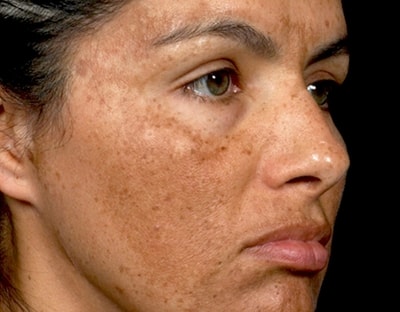Learn how to treat Hyperpigmentation. If you are one of the thousands of people who suffer from too many freckles, old age spots, discolored acne scars, or an uneven skin tone and want to do something about it you may be considering some of the hyperpigmentation treatments that are available today.
It can be a difficult choice as all these different treatments have at least some negative side effects, can often be costly, and many times do not get you the results you are hoping for. Let’s take a look at the different treatments that are available today.
How to treat Hyperpigmentation: Chemical Peels
Chemical peels have been around for some time now and are offered as a viable choice for hyper-pigmentation. There are three distinct levels of chemical peel treatments called superficial, moderate, and deep.
Superficial chemical peels remove just the top layer of skin and is used in cases where the discoloration is very light. However, even for light freckles and age spots more than one treatment is advised and often as many as 3 to five. At a cost of $150 to $300 a treatment, you could end up paying over a $1,000 to have lighter skin and still end up with two tone skin as hypopigmentation (lack of pigment) is sometimes a side of effect of chemical peel treatments.
 Moderate chemical peels are even worse as these peels penetrate several layers of skin, take at least a couple of weeks to recover from and require daily soaks and antiviral medications to keep your skin from becoming infected. In addition, some people experience scarring from the procedure itself. Worse for this iffy outcome, you can expect to pay anywhere from $1000 to $3000 per treatment and often times 2 or more treatments are needed to really even your skin tone.
Moderate chemical peels are even worse as these peels penetrate several layers of skin, take at least a couple of weeks to recover from and require daily soaks and antiviral medications to keep your skin from becoming infected. In addition, some people experience scarring from the procedure itself. Worse for this iffy outcome, you can expect to pay anywhere from $1000 to $3000 per treatment and often times 2 or more treatments are needed to really even your skin tone.
Deep Chemical peels are extremely painful and usually done in the hospital as an outpatient procedure and requiring some medications to deaden the pain during the procedure. Deep chemical peels are done one small area at a time and cold compresses are used to cool the skin.
After the procedure you must wear sterile bandages, you will feel like you have been burned and you will need to soak daily, and take antiviral medications for at least two weeks. During the healing time you skin will be more susceptible to infections, you will have crusting and have more risk of scarring and for all this you can expect to pay anywhere from $3000 to $5000. And no – this procedure isn’t part of the Anne Hathaway skin care routine.
With all chemical peels, there is some risk of scarring, hypopigmetation and in some cases, Arrhythmia from the skin absorbing the phenol.
How to treat Hyperpigmentation: Laser Treatments
Laser treatments are usually not recommended for hyperpigmentation. However, if your dermatologist has tried other kinds of treatments without satisfactory results they may turn to lasers to get rid of those old age spots, scars, and freckles. There are a couple of different laser treatments your dermatologist may use and both have been proven to be expensive and requires some healing time in some cases as much as several weeks.
Like chemical peels, laser treatments for hyperpigmentation may result in both scarring and hypopigmentation and in the cases of darker skinned individuals may actually increase the amount of hyperpigmentation.
How to treat Hyperpigmentation: Microdermabrasion
Microdermabrasion is the least risky and least costly of the hyperpigmentation treatments offered by your dermatologist and is sometimes done at spas. This treatment “sands” the top layer of skin off the area in the hopes of removing or at least lightening those discoloration spots. It can only be used for very light cases of hyperpigmentation and costs about $150.00 to $200.00 dollars a treatment. While this type of treatment is less painful than laser treatments or chemical peels it is uncomfortable and darker skin people sometimes end up with hyperpigmentation or hypopigmentation resulting in still having darker or lighter spots and an uneven skin tone.
How to treat Hyperpigmentation: Hydroquione
Hydroquione is enzyme blocker that blocks the production of melanin, which is what causes pigment. Because it blocks the production of pigment it takes several weeks to start to see the results as the discolored pigmented skin that is already present has to die and fall off.
The problem with Hydroquione is that it can often be quite dangerous causing severe allergic reactions such as hives, breathing difficulties, swelling of the face, lips, throat and tongue. In additions areas that are treated may itch, burn and even crust and Hydroquione has also been linked to cancer and liver failure.
You can get this product both in over the counter skin lighteners and in stronger prescription form but, misuse of this can lead to some serious health risks.
All Natural Skin Lighteners
Most people find all natural skin lighteners the perfect choice. These lighteners take a little longer to achieve the desired results but, often times you can see them working. Most all natural skin lighteners are far less costly that other hyperpigmentation treatments, don’t result in scarring, or missed time at work due to recovery, and you never have to worry about risk of infection.
Using a natural skin lightener like Revitol Skin Brightener Cream, can effectively lighten those dark spots, even your skin tone, and give you the complexion you have been begging for safely and without worry about negative side effects.


